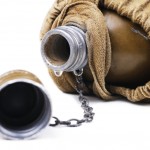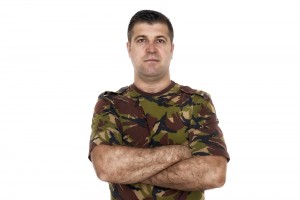
Readers of the Mental Elf will be aware that problematic drinking is a major issue in the UK; 24.2% of the UK population are classed as hazardous drinkers (8+ AUDIT scores) and 3.8% as harmful drinkers (16+ AUDIT scores). Two-thirds of harmful drinkers show symptoms of alcohol dependence (NICE 2011). Although alcohol misuse is a major problem in its own right, it is argued that alcohol misuse in combination with other mental illnesses may have especially poor outcomes.
One illness that may be particularly problematic when comorbid with alcohol misuse is Post Traumatic Stress Disorder (PTSD). Although the rates of comorbidity between PTSD and alcohol misuse are not as high as some disorders (e.g. anxiety and depression) this does not mean PTSD with alcohol misuse is not a major issue. Indeed, symptoms of each disorder may mask each other, outcomes may be poorer than for either illness in isolation, and alcohol misuse may sometimes be a consequence of PTSD.
The current review focuses on the comorbidity between PTSD and alcoholism with additional focus on whether particular symptoms of PTSD are associated with alcohol misuse.

One in four UK residents are classed as hazardous drinkers, but the risks of harm increase still further when this is combined with a mental health problem such as PTSD.
Methods
The authors conducted a systematic review of research that investigated prevalence of both alcohol misuse and PTSD. There were stringent inclusion criteria (reflected in the estimated quality of studies reviewed), these included at least 100 participants, adult samples, standardized or clinically diagnosed PTSD and specific analysis of alcohol misuse (i.e. not as part of a broader measure of substance abuse).
42 studies met these criteria, with 31 scoring three or more for quality. The authors also classified studies as to whether participants were treatment seeking or non-treatment seeking. The association between alcohol misuse and the three symptom clusters of PTSD was also analysed.
PTSD symptom clusters
- Cluster B: Re-experiencing
- Cluster C: Avoidance and numbing
- Cluster D: Hyper arousal
Comorbidity rates were described separately for studies investigating populations that had:
- Not previously been defined as suffering from PTSD or alcohol misuse
- Been previously defined as having PTSD or
- Been previously defined as having alcohol misuse
Results
- Populations not previously defined as having either disorder (N=2)
- Prevalence from 15.9% to 25%
- Populations defined as having PTSD (N=15)
- Prevalence 9.8% to 61.3%
- Populations defined as having alcohol misuse problems (N=14)
- 2% to 60%
- Most falling in 15% to 30% range
- Military populations had the highest rates of co morbid PTSD with alcohol misuse
- Association between different PTSD symptom clusters and alcohol misuse (N=9)
- Cluster C symptoms were associated with alcohol misuse in all but one of these studies
- Further exploration of cluster C symptomology found that there was a tendency for numbing to have a stronger association with alcohol misuse than avoidance
- Cluster D symptoms were also found to be associated with alcohol misuse, although findings regarding cluster B symptoms were inconsistent.

This systematic review suggests that at least 10% of those with PTSD also exhibit alcohol misuse.
Conclusions
This review highlights the association between PTSD and alcohol misuse suggesting at least 10% of those with PTSD also exhibit alcohol misuse, particularly in those exhibiting cluster C and D symptoms. Treatment seeking compared to not treatment seeking did not differ in severity of symptoms, but there was some evidence for a correlation between severity of alcohol misuse and PTSD.
The authors argue that this comorbidity is a major concern and that current NICE guidelines may not be sufficient for dealing with the problem as they state PTSD should not be dealt with unless alcohol dependence is first treated. The content of this review make it concerning that there are no specific guidelines for the treatment of comorbid PTSD and alcohol misuse.
Overall this paper does an excellent job of reviewing the data on comorbid PTSD and alcohol misuse. The summary table is extremely thorough and would be useful for clinicians or students. In the future, the elf would like to see a meta-analysis investigating comorbidity between alcohol misuse and PTSD with particular emphasis put on differences in prevalence in different groups, e.g. veterans, disaster survivors etc (such a meta-analysis could have political as well as medical implications).

Current NICE guidelines make it hard for clinicians to know how to manage PTSD when it is comorbid with alcohol misuse.
Link
Debell F, Fear NT, Head M, Batt-Rawden S, Greenberg N, Wessely S, Goodwin L. A systematic review of the comorbidity between PTSD and alcohol misuse. Soc Psychiatry Psychiatr Epidemiol. 2014 Sep;49(9):1401-25. doi: 10.1007/s00127-014-0855-7. Epub 2014 Mar 19. [Abstract]

this is an area we are looking at http://t.co/zgwojrxDmb
RT @Mental_Elf: Alcohol misuse and PTSD comorbidity: a significant problem lacking solutions http://t.co/cLtTz15X0I
Alcohol misuse and PTSD comorbidity: a significant problem lacking solutions: Current NICE guidelines state th… http://t.co/FpnJAh38XF
Morning @WesselyS We’ve blogged about your PTSD & alcohol misuse SR today. Welcome your comments: http://t.co/UBcQuLJXWc
@Mental_Elf @WesselyS in my clinical experience solutions lay in coordinating services. Presently pts rarely given dual input.
Alcohol misuse and PTSD comorbidity: a significant problem lacking solutions http://t.co/NglRL915ZZ via @sharethis
Today @ChristiansenLiv on a systematic review of the comorbidity between PTSD & alcohol misuse http://t.co/UBcQuLJXWc
An excellent summary of this work on a very important issue that’s mishandled at the moment in the NHS because of the antiquated guidelines on treating the alcoholism and PTSD consecutively instead of simultaneously. One very good manual for working with them simultaneously is Najavits, Seeking Safety.
I really appreciated your write-up, and bringing out the NHS and political contexts. Two minor points I’d personally brought in. The classification of 3 symptom clusters of PTSD is that of DSM-IV. The sooner new research uses DSM-5, the better it will be for long-term comparability. DSM-5 didn’t make big changes to PTSD, but it did rearrange the symptoms into 4 instead of 3 groups.
And second, I’d have added a few sentences about the study being correlational, and the limitations that puts on interpreting the numbers. It may be obvious to statistically knowledgeable readers, but experience proves that this more or less *always* needs to be explained.
Otherwise, thanks so much for this excellent highlighting of an important issue, affecting countless people!
Exc’t insightful comment on major issue in NHS pr’ce: guideline not to treat #PTSD & alcohol use simultaneously. http://t.co/LFMB9GbocF
my latest offering for the @Mental_Elf Alcohol misuse and PTSD comorbidity http://t.co/W4Yeyra8eb
“@ChristiansenLiv: my latest offering for the @Mental_Elf Alcohol misuse and PTSD comorbidity http://t.co/VRbolAlpAD” great article
New blog: http://t.co/UBcQuLJXWc #Alcohol misuse and #PTSD comorbidity http://t.co/pCjwHbItlL
RT: @Mental_Elf: Alcohol misuse and PTSD comorbidity: a significant problem lacking solutions http://t.co/5YfYbxdy2Y”
Alcohol misuse and PTSD comorbidity: a significant problem lacking solutions
http://t.co/Iv6UBe3W8Q
Mental Elf: Alcohol misuse and PTSD comorbidity: a significant problem lacking solutions http://t.co/7x90SGaVH6
Is @NICEcomms guidance a help or hindrance to clinicians trying to care for ppl w/ comorbid PTSD & alcohol misuse? http://t.co/UBcQuLJXWc
Don’t miss – Alcohol misuse and PTSD comorbidity: a significant problem lacking solutions http://t.co/UBcQuLJXWc
@Mental_Elf – this often ignored area needs significant resources allocated so that these patients can rapidly have the care they deserve
@Mental_Elf PTSD and anything above minimal alcohol consumption totally incompatible. Plenty of options available to reduce or abstain.
Princess Sunshyne liked this on Facebook.
Alcohol misuse & #PTSD comorbidity: a significant problem lacking solutions http://t.co/uGEu8Kzv20 Review of the #evidence from @Mental_Elf
@Mental_Elf @WesselyS Cohort doesn’t mention child abuse or co-morbidity with other diagnoses. PTSD one of family of co-morbid conditions.
Alcohol misuse and #PTSD comorbidity: A significant problem lacking solutions http://t.co/JkrHILBBrr @Mental_Elf